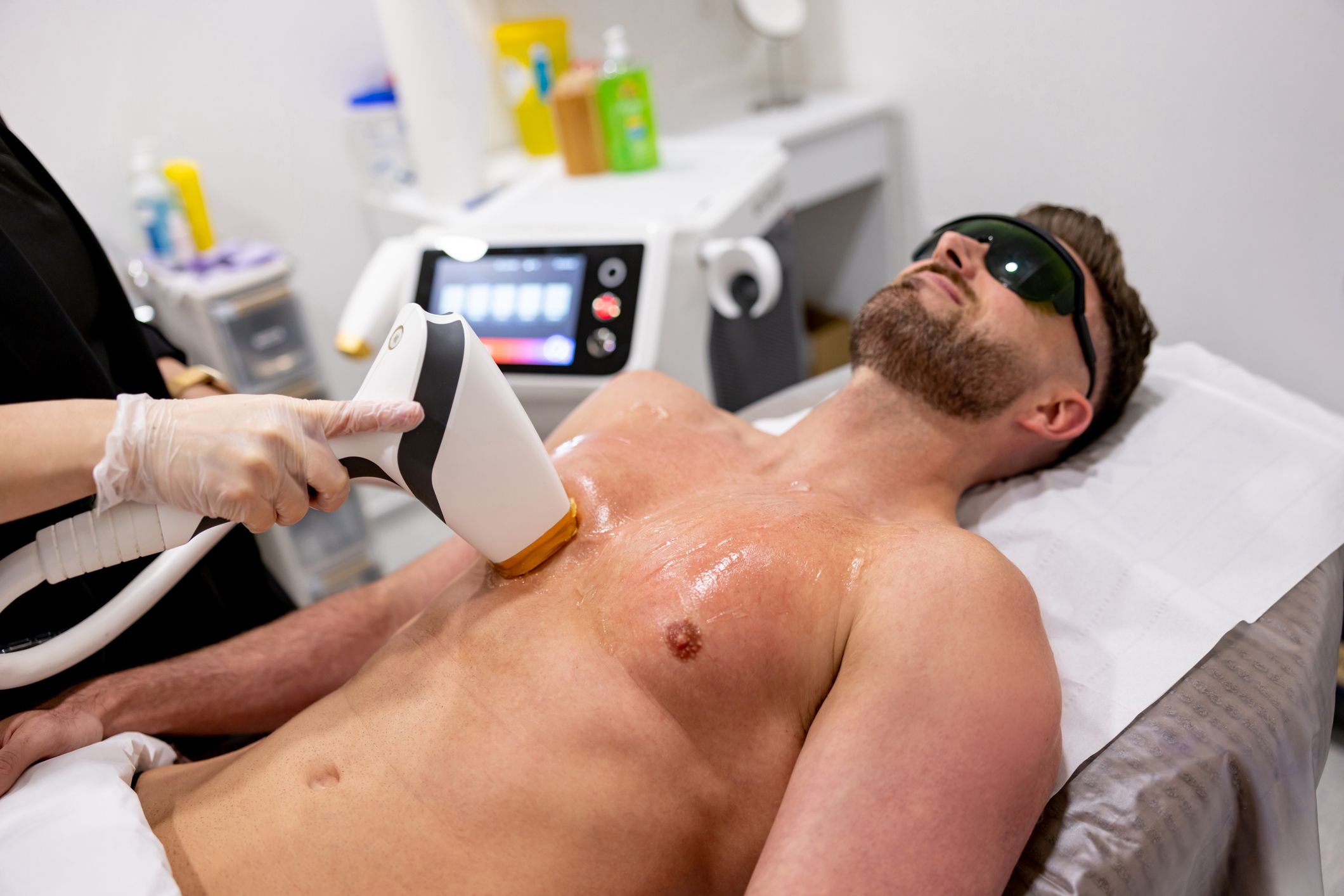

FAQs
How Much Does Laser Hair Removal Cost
Modified: September 23, 2023
Get an idea of the average cost of laser hair removal treatment. Find answers to general questions about laser hair removal pricing and expenses.
(Many of the links in this article redirect to a specific reviewed product. Your purchase of these products through affiliate links helps to generate commission for Under-tec.com, at no extra cost. Learn more)
Table of Contents
- Introduction
- Factors Affecting the Cost of Laser Hair Removal
- Average Cost of Laser Hair Removal
- Cost Comparison of Different Body Parts
- Cost Variation Across Different Locations
- Additional Costs to Consider
- Factors to Consider When Choosing a Laser Hair Removal Clinic
- DIY vs. Professional Laser Hair Removal: Cost Comparison
- Insurance Coverage for Laser Hair Removal
- Conclusion
Introduction
Unwanted hair can be a hassle, leading many individuals to seek out effective and long-lasting hair removal solutions. Among the various options available, laser hair removal has gained popularity for its ability to provide permanent hair reduction. However, before undergoing this procedure, it’s important to understand the cost associated with it.
Laser hair removal is a cosmetic procedure that uses concentrated light to target and damage hair follicles, inhibiting future hair growth. The cost of laser hair removal can vary depending on several factors, including the size of the treatment area, the number of sessions required, the geographic location of the clinic, and the experience of the practitioner.
In this article, we will delve into the various factors that can affect the cost of laser hair removal. We will also discuss the average cost of this procedure, provide a cost comparison for different body parts, and explore the variation in costs across different locations. Additionally, we will highlight other potential costs to consider and offer insights to help you make an informed decision when choosing a laser hair removal clinic.
Moreover, we will compare the cost of professional laser hair removal treatments to the expenses associated with DIY (do-it-yourself) options. Lastly, we will address the question of whether insurance coverage is available for laser hair removal.
By the end of this article, you will have a comprehensive understanding of the factors affecting the cost of laser hair removal, enabling you to make an informed decision about this popular hair removal method.
Factors Affecting the Cost of Laser Hair Removal
The cost of laser hair removal can vary significantly due to several factors. Understanding these factors will help you determine the final price and plan your budget accordingly.
1. Treatment Area: The size of the area being treated is one of the most significant factors affecting the cost. Generally, larger areas, such as the back or legs, require more time and resources, resulting in higher prices compared to smaller areas like the upper lip or underarms.
2. Number of Sessions: Laser hair removal typically requires multiple sessions to achieve optimal results. The number of sessions needed varies depending on factors such as hair thickness, color, and the individual’s response to treatment. Each session adds to the overall cost, so be sure to inquire about package deals or discounts for multiple sessions.
3. Geographic Location: The cost of laser hair removal can vary based on the location of the clinic. Larger cities or areas with high demand often have higher prices compared to smaller towns or less populated regions. Keep in mind that the cost might also be influenced by the overall cost of living in a particular area.
4. Practitioner’s Experience: The level of expertise and experience of the practitioner can influence the cost of laser hair removal. Highly skilled practitioners who have extensive training and a track record of successful results may charge higher fees due to their expertise.
5. Technology and Equipment: The type of laser technology used can impact the cost. Advanced laser systems that provide faster and more effective results might be associated with a higher price tag. However, it’s important to prioritize safety and quality over cost when selecting a clinic or practitioner.
6. Customization and Individual Needs: Every person’s hair removal needs are unique. Some individuals require more customized treatment plans due to factors such as hormonal imbalances or specific skin conditions. Tailored treatment options might come at a higher cost to address these individual needs.
7. Clinic Reputation: Established and reputable clinics often charge higher prices due to their reputation and demand. Choosing a clinic known for its quality service and customer satisfaction can provide peace of mind, although it may come with a higher price tag.
By considering these factors, you can better understand why costs may vary among different laser hair removal clinics. Taking the time to research and compare pricing options will help you find the most suitable and cost-effective solution for your hair removal needs.
Average Cost of Laser Hair Removal
The cost of laser hair removal can vary depending on the factors mentioned earlier, but it’s helpful to have a general idea of the average cost range for this procedure. The prices provided below serve as a rough estimate and may differ depending on individual circumstances and location.
On average, a single laser hair removal session can cost anywhere between $200 to $500. However, it’s important to note that multiple sessions are usually required for optimal results, with an average of six to eight sessions recommended. This means that the total cost for a full treatment course can range from $1,200 to $4,000.
The cost of laser hair removal can also vary depending on the body part being treated. Here is a breakdown of the average cost for laser hair removal on different body parts:
- Upper lip or chin: $75 – $200 per session
- Underarms: $150 – $250 per session
- Bikini area: $250 – $500 per session
- Full legs: $600 – $1,200 per session
- Back or chest: $500 – $900 per session
Keep in mind that these costs are approximate and can differ based on various factors, including the clinic, technology used, and the region in which you live.
Additionally, many clinics offer package deals or discounts for multiple sessions. These packages can help reduce the overall cost of laser hair removal. It’s important to discuss your goals and budget with the clinic to determine the most cost-effective option for you.
While the cost of laser hair removal may seem high, it’s essential to consider the long-term benefits. Laser hair removal offers long-lasting results compared to temporary hair removal methods such as waxing, shaving, or using depilatory creams. Over time, the cost of ongoing temporary methods can add up, making laser hair removal a worthwhile investment for those seeking a more permanent solution.
Next, we will explore how the cost of laser hair removal can vary across different locations, helping you understand the geographical influence on pricing.
Cost Comparison of Different Body Parts
The cost of laser hair removal can vary depending on the body part being treated. Different areas of the body require varying levels of expertise, time, and resources, which can affect the overall cost. Here is a breakdown of the average cost range for laser hair removal on different body parts:
- Upper Lip or Chin: This is one of the smaller treatment areas and typically costs between $75 to $200 per session. The precise cost may depend on factors such as hair thickness and the specific clinic you choose.
- Underarms: Laser hair removal for the underarms generally ranges from $150 to $250 per session. This area is relatively small, making it more affordable compared to larger body parts.
- Bikini Area: The cost for laser hair removal in the bikini area can vary widely depending on the extent of the treatment. On average, it ranges from $250 to $500 per session.
- Full Legs: Treating the entire leg area can be more expensive due to the larger surface area. The cost for full leg laser hair removal can range from $600 to $1,200 per session.
- Back or Chest: Laser hair removal on the back or chest tends to be priced higher compared to other body parts. This is primarily due to the larger treatment area. The cost can range from $500 to $900 per session.
It’s important to note that these prices are estimates and can vary depending on factors such as location, clinic reputation, technology used, and any additional customization required for your specific needs.
When considering the cost comparison of different body parts for laser hair removal, it’s essential to prioritize your needs and budget. For example, some individuals may choose to prioritize certain areas like the bikini area or underarms over larger body parts due to personal preferences or lifestyle factors.
Additionally, many clinics offer package deals or discounts for multiple sessions or combination treatments, which can help reduce the overall cost. It’s worth exploring these options and discussing them with your chosen clinic to find the best plan that fits your budget and hair removal goals.
Now that we’ve explored the cost comparison by body parts, let’s dive into how the cost of laser hair removal can vary across different locations.
Cost Variation Across Different Locations
The cost of laser hair removal can vary significantly depending on the geographic location of the clinic. Factors such as the local economy, demand for services, and competition among clinics can contribute to these cost variations.
Clinics located in larger cities or areas with high demand for cosmetic procedures tend to have higher prices compared to those in smaller towns or less populated regions. This is often due to the higher cost of living and overhead expenses associated with operating in such areas.
For example, laser hair removal prices in major metropolitan areas like New York City or Los Angeles may be higher compared to smaller towns in rural areas. On average, the cost of laser hair removal in a metropolitan area can be around 20-30% higher than in less populated regions.
In addition to the size of the city, the overall competitiveness of the market can also impact pricing. In areas with a high concentration of laser hair removal clinics, the competition among providers may lead to more competitive pricing. As a result, prices in these areas can be slightly lower compared to regions with fewer options.
It’s important to note that while cost variation exists, choosing a reputable and experienced provider should be a priority over solely considering price. Opting for a highly skilled practitioner and a well-established clinic that prioritizes safety and quality can ensure the best results and minimize the risk of complications. Quality and expertise may come at a higher cost, but the long-term benefits and peace of mind are worth the investment.
When researching laser hair removal clinics, consider comparing prices in your area and neighboring regions to get a sense of the average cost. Obtain quotes from different clinics and inquire about any package deals or discounts they may offer. Additionally, read reviews and seek recommendations to assess the quality of service provided by each clinic.
By considering the cost variations across different locations, you can better plan and budget for your laser hair removal treatments. Remember to prioritize safety and quality when choosing a clinic, as it is equally important as the cost itself.
Now that we understand the cost variation across different locations, let’s explore additional costs to consider when it comes to laser hair removal.
Additional Costs to Consider
When calculating the cost of laser hair removal, it’s important to consider not only the price of the treatment sessions but also any additional costs that may arise throughout the process. Here are some additional costs to keep in mind:
Consultation Fees: Some clinics may charge a separate consultation fee to assess your suitability for laser hair removal and discuss your goals and expectations. This fee typically ranges from $50 to $100, but some clinics may offer free consultations.
Preparatory Costs: Prior to your laser hair removal treatment, you may be required to prepare the treatment area by shaving the hair. This may involve purchasing shaving supplies and potentially specialized shaving products recommended by the clinic.
Additional Treatment Sessions: While the average number of sessions for laser hair removal is six to eight, some individuals may require additional sessions to achieve the desired results. Each additional session will add to the overall cost of the treatment.
Post-Treatment Products: After laser hair removal, it’s important to take care of your skin and follow the recommended aftercare routine. This may involve purchasing post-treatment products such as moisturizers, soothing creams, or serums to enhance the healing process and maintain skin health.
Maintenance Sessions: While laser hair removal offers long-lasting results, some individuals may require occasional maintenance sessions to address any regrowth or new hair follicles that were not originally treated. These maintenance sessions can incur additional costs in the long run.
Travel Expenses: If you choose to undergo laser hair removal at a clinic that is not local to you, travel expenses such as transportation, accommodation, and meals may need to be factored into your overall cost.
Be sure to discuss these potential additional costs with the clinic during your consultation or when obtaining a price quote. It’s essential to have a clear understanding of the full cost commitment and any potential additional expenses that may arise.
Next, let’s explore the factors you should consider when choosing a laser hair removal clinic to ensure you make the best decision for your specific needs and budget.
Factors to Consider When Choosing a Laser Hair Removal Clinic
Choosing the right laser hair removal clinic is crucial to ensure a safe and effective treatment. When considering different clinics, it’s important to evaluate several key factors to make an informed decision. Here are some factors to consider when choosing a laser hair removal clinic:
Qualifications and Experience: Research the qualifications and experience of the practitioners at the clinic. Ensure that they are certified and have undergone the necessary training in laser hair removal. Experienced practitioners are more likely to provide quality treatments and minimize the risk of complications.
Reputation and Reviews: Look for reviews and testimonials from previous clients to gauge the clinic’s reputation. Positive reviews and recommendations can give you confidence in the clinic’s ability to deliver satisfying results and excellent customer service.
Clinic Facilities and Technology: Visit the clinic or explore their website to assess the cleanliness and professionalism of the facilities. Inquire about the type of laser technology used. Modern and advanced laser systems tend to be more efficient and provide better results with less discomfort.
Pricing and Packages: Compare the pricing of different clinics and inquire about any package deals or discounts they may offer. Keep in mind that the cheapest option may not always be the best, so balance affordability with quality and expertise.
Consultation Process: Find out if the clinic offers a consultation prior to the treatment. A consultation allows you to discuss your concerns, expectations, and ask any questions you may have. It’s an opportunity to assess the clinic’s professionalism and determine if you feel comfortable with the staff and environment.
Customer Service: Pay attention to the level of customer service provided by the clinic. Friendly and knowledgeable staff who are willing to address your queries and guide you through the process can greatly enhance your overall experience.
Before and Aftercare: Inquire about the clinic’s pre and post-treatment guidelines. A reputable clinic should provide you with clear instructions on how to prepare for your treatment and how to care for your skin afterward. Adequate before and aftercare can contribute to the success of your treatment and minimize any potential side effects.
Open Communication: Choose a clinic where you feel comfortable discussing your concerns and goals openly. A good clinic will listen to your needs, provide honest advice, and tailor the treatment plan to your specific requirements.
Taking the time to consider these factors will help you choose a laser hair removal clinic that meets your expectations, provides quality service, and ensures safe and effective treatments.
Next, we will compare the cost of professional laser hair removal treatments to the expenses associated with DIY (do-it-yourself) options.
DIY vs. Professional Laser Hair Removal: Cost Comparison
When considering laser hair removal, some individuals may be tempted to opt for do-it-yourself (DIY) alternatives to save money. While these options may seem more affordable upfront, it’s essential to understand the potential risks and limitations compared to professional laser hair removal. Here is a cost comparison between DIY and professional laser hair removal:
DIY Methods:
DIY methods for hair removal typically include at-home laser devices, handheld IPL devices, waxing kits, or hair removal creams. These options are generally less expensive than professional treatments, with upfront costs ranging from $20 to $500.
However, it’s important to note that DIY methods often require multiple sessions and ongoing maintenance to achieve and maintain desired results. This means that the overall cost may accumulate over time due to the need for frequent device usage or product repurchases.
Furthermore, DIY options may not provide the same level of precision, effectiveness, or safety as professional treatments. Without proper training and expertise, there is a higher risk of ineffective results, skin damage, or even burns. The lack of professional oversight and guidance can lead to suboptimal outcomes and potential harm.
Professional Laser Hair Removal:
Professional laser hair removal, while initially more expensive than DIY methods, offers several advantages. The cost per session typically ranges from $200 to $500, depending on factors such as the treatment area and the clinic’s location.
Professional treatments are carried out by trained practitioners who use medical-grade laser equipment. This ensures a higher level of precision, safety, and effectiveness. The expertise of the practitioner allows for customized treatment plans tailored to your specific needs and ensures optimal results from the treatment.
Additionally, professional laser hair removal offers long-lasting results. Unlike temporary DIY methods, professional treatments target hair follicles at the root, inhibiting future hair growth. This eliminates the need for ongoing maintenance and frequent touch-ups, ultimately saving you time and money in the long run.
While the upfront cost of professional laser hair removal may be higher, the investment provides a more permanent and reliable solution to unwanted hair growth.
Ultimately, the decision between DIY and professional laser hair removal depends on your budget, desired results, and willingness to accept potential risks. It’s crucial to weigh the cost savings of DIY methods against the quality, safety, and long-term benefits provided by professional treatments when making your choice.
Now, let’s explore the possibility of insurance coverage for laser hair removal and how it may impact the overall cost.
Insurance Coverage for Laser Hair Removal
When it comes to laser hair removal, insurance coverage varies depending on the circumstances. In general, most insurance companies consider laser hair removal to be a cosmetic procedure rather than a medically necessary one. As a result, they typically do not provide coverage for the cost of the treatment.
However, there are exceptions to this rule. In some cases, laser hair removal may be deemed medically necessary if it is required for the treatment of a specific medical condition. For example, individuals with a condition called hirsutism, which causes excessive hair growth due to hormonal imbalances, may be eligible for insurance coverage.
For insurance coverage to be considered, a comprehensive evaluation by a healthcare professional is typically required to determine the medical necessity of the treatment. The healthcare provider will evaluate your specific circumstances, medical history, and the severity of the condition to make a case for insurance coverage.
If you believe that your laser hair removal treatment may be medically necessary, it is essential to consult with your healthcare provider and insurance company to determine eligibility for coverage. Be prepared to provide necessary documentation, such as medical reports and supporting documents, to support your claim.
It’s important to note that even if insurance coverage is approved for laser hair removal, it may only cover a portion of the overall cost. Deductibles, co-pays, and coverage limits may still apply, and you may be responsible for covering the remaining expenses.
Before undergoing laser hair removal, it’s crucial to review your insurance policy, contact your insurance provider directly, and discuss the specifics of coverage and potential reimbursement options. This will help you understand the financial implications and make informed decisions regarding your treatment.
If insurance coverage is not available or only covers a portion of the cost, exploring payment plans or financing options offered by the clinic may be worth considering. Many clinics provide flexible payment options that can help you manage the cost of laser hair removal within your budget.
Now that we have explored the possibility of insurance coverage, let’s summarize the key points discussed and wrap up the article.
Conclusion
Laser hair removal is a popular method for achieving long-lasting hair reduction. However, it’s important to consider the various factors that can affect the cost of this procedure. The size of the treatment area, the number of sessions required, the geographic location of the clinic, and the experience of the practitioner all play a role in determining the overall cost.
The average cost of laser hair removal can range from $1,200 to $4,000 for a full treatment course, with individual sessions typically costing between $200 and $500. Additionally, the cost can vary depending on the specific body part being treated, with larger areas like the legs or back generally being more expensive than smaller areas like the upper lip or underarms.
It’s important to consider the cost variation across different locations, as clinics in larger cities or areas with high demand may have higher prices compared to those in smaller towns. However, prioritizing the expertise, reputation, and safety of the clinic is crucial when making your decision, as quality and experience should not be compromised solely for cost considerations.
When comparing professional laser hair removal to DIY options, it’s essential to recognize the potential risks and limitations of at-home methods. While DIY options may seem more affordable upfront, they often require ongoing maintenance and may not provide the same level of precision and effectiveness as professional treatments.
Insurance coverage for laser hair removal is generally limited, with most insurance companies classifying it as a cosmetic procedure. However, in specific cases where laser hair removal is deemed medically necessary, such as the treatment of hirsutism, insurance coverage may be available. Consulting with your healthcare provider and insurance company can help determine eligibility and coverage options.
Overall, laser hair removal can be a worthwhile investment for those seeking a more permanent solution to unwanted hair. By considering the cost factors, researching reputable clinics, and discussing payment options, you can make an informed decision that aligns with your budget and hair removal goals.
Remember, the cost of laser hair removal is just one aspect to consider. Prioritize your safety, comfort, and the expertise of the clinic when making your decision, ensuring you receive the best possible results and a satisfying laser hair removal experience.









